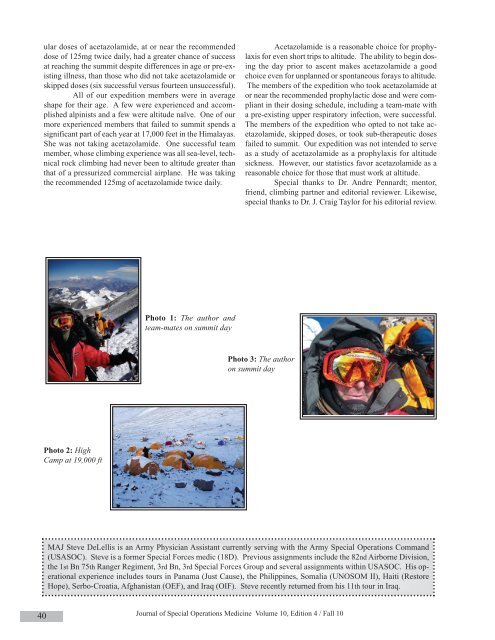Fall - United States Special Operations Command
Fall - United States Special Operations Command
Fall - United States Special Operations Command
You also want an ePaper? Increase the reach of your titles
YUMPU automatically turns print PDFs into web optimized ePapers that Google loves.
40<br />
ular doses of acetazolamide, at or near the recommended<br />
dose of 125mg twice daily, had a greater chance of success<br />
at reaching the summit despite differences in age or pre-existing<br />
illness, than those who did not take acetazolamide or<br />
skipped doses (six successful versus fourteen unsuccessful).<br />
All of our expedition members were in average<br />
shape for their age. A few were experienced and accomplished<br />
alpinists and a few were altitude naïve. One of our<br />
more experienced members that failed to summit spends a<br />
significant part of each year at 17,000 feet in the Himalayas.<br />
She was not taking acetazolamide. One successful team<br />
member, whose climbing experience was all sea-level, technical<br />
rock climbing had never been to altitude greater than<br />
that of a pressurized commercial airplane. He was taking<br />
the recommended 125mg of acetazolamide twice daily.<br />
Photo 2: High<br />
Camp at 19,000 ft<br />
Photo 1: The author and<br />
team-mates on summit day<br />
Acetazolamide is a reasonable choice for prophylaxis<br />
for even short trips to altitude. The ability to begin dosing<br />
the day prior to ascent makes acetazolamide a good<br />
choice even for unplanned or spontaneous forays to altitude.<br />
The members of the expedition who took acetazolamide at<br />
or near the recommended prophylactic dose and were compliant<br />
in their dosing schedule, including a team-mate with<br />
a pre-existing upper respiratory infection, were successful.<br />
The members of the expedition who opted to not take acetazolamide,<br />
skipped doses, or took sub-therapeutic doses<br />
failed to summit. Our expedition was not intended to serve<br />
as a study of acetazolamide as a prophylaxis for altitude<br />
sickness. However, our statistics favor acetazolamide as a<br />
reasonable choice for those that must work at altitude.<br />
<strong>Special</strong> thanks to Dr. Andre Pennardt; mentor,<br />
friend, climbing partner and editorial reviewer. Likewise,<br />
special thanks to Dr. J. Craig Taylor for his editorial review.<br />
Photo 3: The author<br />
on summit day<br />
MAJ Steve DeLellis is an Army Physician Assistant currently serving with the Army <strong>Special</strong> <strong>Operations</strong> <strong>Command</strong><br />
(USASOC). Steve is a former <strong>Special</strong> Forces medic (18D). Previous assignments include the 82nd Airborne Division,<br />
the 1st Bn 75th Ranger Regiment, 3rd Bn, 3rd <strong>Special</strong> Forces Group and several assignments within USASOC. His operational<br />
experience includes tours in Panama (Just Cause), the Philippines, Somalia (UNOSOM II), Haiti (Restore<br />
Hope), Serbo-Croatia, Afghanistan (OEF), and Iraq (OIF). Steve recently returned from his 11th tour in Iraq.<br />
Journal of <strong>Special</strong> <strong>Operations</strong> Medicine Volume 10, Edition 4 / <strong>Fall</strong> 10

















